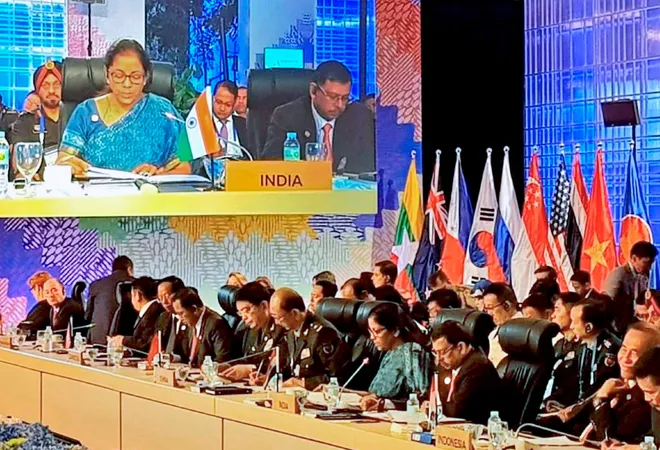< style="color: #000000">In her first foreign visit as Defence Minister, Nirmala Sitharaman travelled to the Philippines earlier this week to attend the ADMM (ASEAN Defence Ministers’ Meeting)-Plus meeting, which focused on the situation in Afghanistan and Syria as well as China’s growing military presence in the disputed South China Sea. Since the commencement of ADMM-Plus in Hanoi in 2010, this group has tended to focus on key issues pertaining to regional security, including maritime security, counter-terrorism, humanitarian assistance, and peacekeeping operations.
An assertive stand on China
Sitharaman, too, in her remarks focused on maritime security as a key regional concern, underlining India’s strong support for freedom of navigation, and overflight and commerce throughout the region.
In the context of China’s assertive behaviour in East and South China Seas, the Indian Defence Minister made it clear that “nations should resolve maritime disputes peacefully and in accordance with international law. We support a rules-based order for oceans and sea that is critical for the continued growth and development of the Indo-Pacific region.”
It is interesting that this came at a time when the Chinese President, Xi Jinping, was emphasising China's controversial island-building project in the South China Sea in his address to the ruling Communist Party's national congress.
‘Radicalisation through social media is a serious concern’
The other focus of Sitharaman’s remarks at the ADMM-Plus meeting was on terrorism. She exhorted other member states to take a strong stand in fighting terror activities; she commended the Philippines “for reiterating India’s zero tolerance for terrorism anywhere and under any circumstances.”
Asking the international community to move away from the binary of good and bad terrorism, she suggested that “terrorism and radicalisation through social media pose one of the most immediate and serious security challenges to our societies.”
< style="color: #000000">Her comments were significant as earlier this year, India decided to provide financial assistance of $5,00,000 (₹3.2 crore) to the Philippines to aid its fight against the Islamic State (IS)-affiliated terror groups in the troubled Mindanao province. This is the first time India is sending aid to another nation to help it fight terrorism, thereby becoming an important marker in New Delhi’s attempts to burnish its credentials as an emerging security provider to the wider Asian region.
New urgency on fight against terrorism
For a long time, India has been trying to convince the world that it remains one of the worst victims of terrorism. But its focus has largely been on Pakistan’s use of terrorism as an instrument of state policy. And where India viewed Pakistan as the epicentre of terrorism, the world remained reluctant to put adequate pressure on a nation that was seen as a close ally in its ‘war against terrorism.’
However, under the Narendra Modi government, India has taken a tough stand on Pakistan’s support for terrorism by underscoring its concerns at various international fora.
In this context, India’s support to Manila shows a new-found sense of urgency in standing shoulder to shoulder with other victims of terror, even when the source of the problem is different.
India’s financial aid significant in ISIS crisis
Earlier this month, Philippine President Rodrigo Duterte declared that Marawi has been liberated from ISIS-affiliated militants following a five-month standoff. The siege of Marawi, about 800 Km south of the capital, Manila, began in May when the Philippine security forces launched an offensive to capture Isnilon Hapilon, leader of the IS-affiliated Abu Sayyaf group.
< style="color: #000000">Duterte took a hard line, vowing to “crush” the militants and declaring martial law over the entire southern Philippines, leading to killing of more than 800 militants and 162 government security forces. It is not readily evident if this will lead to an end of militancy, but the IS has suffered a serious setback in the region. India has expressed its concerns at the situation and used this crisis to enhance its anti-terror and deradicalisation partnership with the Philippines. India is also conducting cybersecurity training for the Philippine security forces, focusing on deradicalisation. And with this financial aid, India has emerged as the largest donor in efforts to contain the crisis.
Challenging China’s dominance in Southeast Asia
< style="color: #000000">China has provided 15 million pesos (approximately $3,00,000) in aid compared to India’s 25 million pesos ($5,00,000). India’s engagement with the Philippines is also key to underscoring its growing role in Southeast Asia where China’s rise has already created serious challenges for the wider region. The regional states are looking at external balancers at a time when America’s commitment to regional security has come under a scanner under the Donald Trump administration. The regional security architecture is under strain there, as China’s divide-and-rule policy has made it difficult for regional states to put up a united front.
< style="color: #000000">Many states have suggested that India needs to play a larger role. As India and the Association of Southeast Asian Nations (ASEAN) celebrate 25 years of their partnership this year, it is a politically opportune moment to upgrade India’s regional profile.
< style="color: #000000">The Philippines has also been trying to recalibrate its ties with China, under stress because of a suit brought by Manila to the Permanent Court of Arbitration in The Hague challenging Beijing’s claim to almost all of the South China Sea. Though Manila won the case last year, it has not been able to push Beijing to moderate its stance on the maritime dispute. Meanwhile, Duterte visited China last year and signed deals worth $24 billion in infrastructure investment and loan pledges.
< style="color: #000000">India cannot easily match China’s growing economic profile but it has other means to build partnership with a very important region in its foreign policy matrix. New Delhi’s outreach to Manila is a step in that direction.
This commentary originally appeared in The Quint.
The views expressed above belong to the author(s). ORF research and analyses now available on Telegram! Click here to access our curated content — blogs, longforms and interviews.




 PREV
PREV


